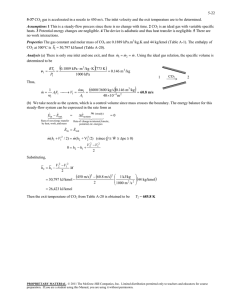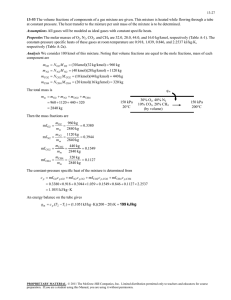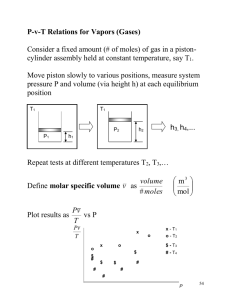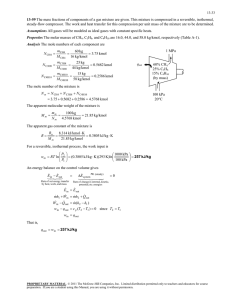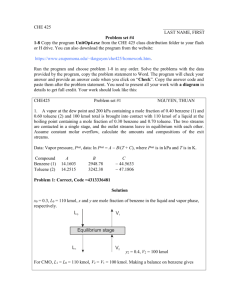The thermal efficiency of this cycle is to be determined.
advertisement
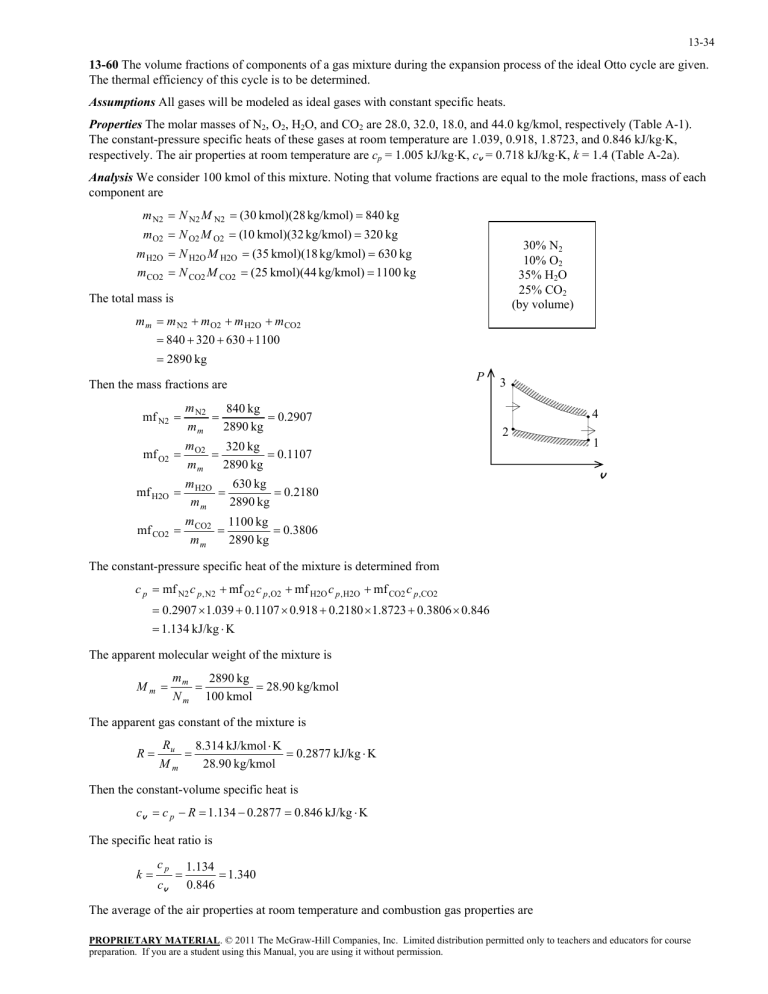
13-34 13-60 The volume fractions of components of a gas mixture during the expansion process of the ideal Otto cycle are given. The thermal efficiency of this cycle is to be determined. Assumptions All gases will be modeled as ideal gases with constant specific heats. Properties The molar masses of N2, O2, H2O, and CO2 are 28.0, 32.0, 18.0, and 44.0 kg/kmol, respectively (Table A-1). The constant-pressure specific heats of these gases at room temperature are 1.039, 0.918, 1.8723, and 0.846 kJ/kgK, respectively. The air properties at room temperature are cp = 1.005 kJ/kgK, cv = 0.718 kJ/kgK, k = 1.4 (Table A-2a). Analysis We consider 100 kmol of this mixture. Noting that volume fractions are equal to the mole fractions, mass of each component are m N2 N N2 M N2 (30 kmol)(28 kg/kmol) 840 kg m O2 N O2 M O2 (10 kmol)(32 kg/kmol) 320 kg 30% N2 10% O2 35% H2O 25% CO2 (by volume) m H2O N H2O M H2O (35 kmol)(18 kg/kmol) 630 kg m CO2 N CO2 M CO2 (25 kmol)(44 kg/kmol) 1100 kg The total mass is m m m N2 m O2 m H2O m CO2 840 320 630 1100 2890 kg Then the mass fractions are mf N2 P m N2 840 kg 0.2907 mm 2890 kg mf O2 m O2 320 kg 0.1107 mm 2890 kg mf H2O m H2O 630 kg 0.2180 mm 2890 kg mf CO2 m CO2 1100 kg 0.3806 mm 2890 kg 3 4 2 1 v The constant-pressure specific heat of the mixture is determined from c p mf N2 c p , N2 mf O2 c p ,O2 mf H2O c p , H2O mf CO2 c p ,CO2 0.2907 1.039 0.1107 0.918 0.2180 1.8723 0.3806 0.846 1.134 kJ/kg K The apparent molecular weight of the mixture is Mm mm 2890 kg 28.90 kg/kmol N m 100 kmol The apparent gas constant of the mixture is R Ru 8.314 kJ/kmol K 0.2877 kJ/kg K 28.90 kg/kmol Mm Then the constant-volume specific heat is cv c p R 1.134 0.2877 0.846 kJ/kg K The specific heat ratio is k cp cv 1.134 1.340 0.846 The average of the air properties at room temperature and combustion gas properties are PROPRIETARY MATERIAL. © 2011 The McGraw-Hill Companies, Inc. Limited distribution permitted only to teachers and educators for course preparation. If you are a student using this Manual, you are using it without permission. 13-35 c p ,avg 0.5(1.134 1.005) 1.070 kJ/kg K cv ,avg 0.5(0.846 0.718) 0.782 kJ/kg K k avg 0.5(1.34 1.4) 1.37 These average properties will be used for heat addition and rejection processes. For compression, the air properties at room temperature and during expansion, the mixture properties will be used. During the compression process, T2 T1 r k 1 (288 K )(8) 0.4 662 K During the heat addition process, q in cv ,avg (T3 T2 ) (0.782 kJ/kg K )(1373 662) K 556 kJ/kg During the expansion process, 1 T4 T3 r k 1 1 (1373 K ) 8 0.37 636.1 K During the heat rejection process, q out cv ,avg (T4 T1 ) (0.782 kJ/kg K )(636.1 288) K 272.2 kJ/kg The thermal efficiency of the cycle is then th 1 q out 272.2 kJ/kg 1 0.511 556 kJ/kg q in PROPRIETARY MATERIAL. © 2011 The McGraw-Hill Companies, Inc. Limited distribution permitted only to teachers and educators for course preparation. If you are a student using this Manual, you are using it without permission.

